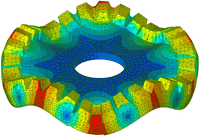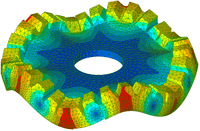Piezoelectric ultrasonic engine
Introduction
Piezoelectric ultrasonic motors offer great advantages over conventional electromagnetic motors (such as torque to size and weight ratio, reduced noise, small and compact, etc.).
Operating mode
The ultrasonic motor consists in a stator (a fixed circular ring), and a rotor, (another circular plate) which is compressed on the vibrating ring and is free to rotate. A set of piezoelectric patches are located on the stator. With the application to those patches of a suitable harmonic electric voltage, a travelling wave can be generated along the ring.
The presence of the travelling wave induces a rotation of the rotor in the opposite direction by contact.
The modelling of the ultrasonic engine involves the use of 3D elements. Several analyses can be performed:
- Modal analysis to determine the right frequency of the signal to apply to the piezoelectric patches (Figure 16 : the conjugated modes)
- Knowing the right frequency, an harmonic analysis can be done to simulate the harmonic response of the coupled system
- The direct integration method using the HHT (Hilbert-Hughes-Taylor) algorithm can also simulate the transient response of the system (from start-up to established harmonic response, for example).


